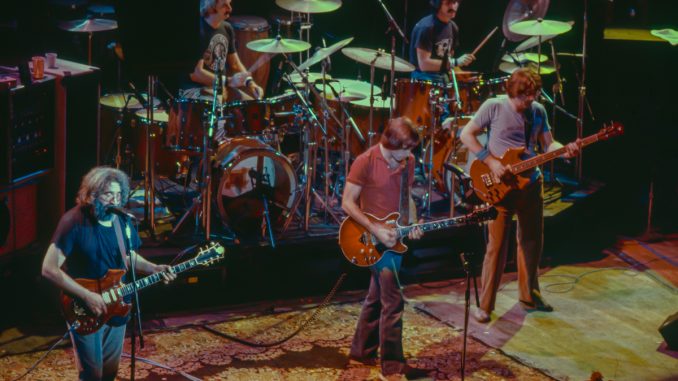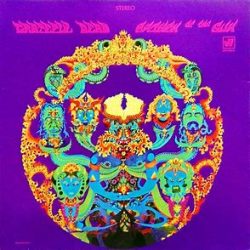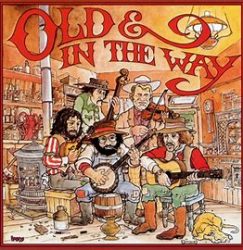
To the uninitiated, getting a handle on what the Grateful Dead are all about can seem quite daunting, and this sense of challenge is exacerbated by the fact that their fanbase, the Deadheads, are probably the most informed and opinionated set of fans in the world. What follows is simply my view on how someone can get an overview of the music of the Grateful Dead that will allow them to either delve deeper, or say no, not for me. However, as with most things in the Grateful Dead world, this is just my opinion, and they will be plenty of alternative views on the subject. If you approach the Grateful Dead as just another rock & roll band, then you will very likely fail to get a true sense of their music, this is because to quote legendary promoter Bill Graham, “They aren’t the best at what they do, they are the only ones that do what they do.”.
The Grateful Dead had a similar early history to most ‘60s bands in that their members were influenced by the folk revival, first-generation rock and roll, blues, and R&B; however, the Grateful Dead moved away from the norm when modern classical music fan and self-taught bass guitarist Phil Lesh joined Jerry Garcia (guitar), Bob Weir (rhythm guitar), Ron “Pigpen” McKernan (keyboards and harmonica), Bill Kreutzmann (drums), and the Grateful Dead became the house band for author Ken Kesey’s Acid Tests. At the time LSD was a legal drug in California, and the free-form nature of the Acid Tests and the experience of a psychedelic acid trip informed the attitude and ebb and flow performance of Grateful Dead concerts and their approach to their career and underlying business model, even after they stopped using the drug itself, and it is this lasting psychedelic influence which is reflected in their iconography that is a significant part of their uniqueness. The other unique aspect of the band is the fact that they actively encouraged fans to tape their shows and trading of tapes among Deadheads helped consolidate the fan base, the only proviso being that fan’s tapes could only be traded not sold. In 1991 the Grateful Dead opened their legendary Vault and started releasing whole concerts on their own Grateful Dead Records, and this regular release of legacy live recordings continues to this day meaning that there is more recorded Grateful Dead music than any other artist or band. The final key ingredient to the Grateful Dead was the lyrics of lyricist Robert Hunter who managed to capture the psychedelic experience and the mythology of American history and society ensuring that the songs written by Garcia and Hunter are some of the greatest songs of the second half of the 20th Century.
 The challenge with Grateful Dead music is that it is only in concert that you can experience the full range of their abilities and sounds, which means that most of their studio recordings fall short of expectations. Also, while they helped pioneered the recording of live music, their two and three hour shows meant that until the vault releases, all official live albums were selective and again did not necessarily give the whole experience. For a band that existing for nearly 30 years which ignores the later variously named aggregations following Jerry Garcia’s death in 1995, they only released 13 studio albums, reinforcing the importance of live recordings to their legacy. If you want to experience the essence of the Grateful Dead via their studio albums then I would recommend 1968’s ‘Anthem Of The Sun’ and 1970’s ‘American Beauty’ as must listens.
The challenge with Grateful Dead music is that it is only in concert that you can experience the full range of their abilities and sounds, which means that most of their studio recordings fall short of expectations. Also, while they helped pioneered the recording of live music, their two and three hour shows meant that until the vault releases, all official live albums were selective and again did not necessarily give the whole experience. For a band that existing for nearly 30 years which ignores the later variously named aggregations following Jerry Garcia’s death in 1995, they only released 13 studio albums, reinforcing the importance of live recordings to their legacy. If you want to experience the essence of the Grateful Dead via their studio albums then I would recommend 1968’s ‘Anthem Of The Sun’ and 1970’s ‘American Beauty’ as must listens.
‘Anthem’ contains only 5 tracks composed by various members of the Grateful Dead, and is a collage of live and studio recordings. It is the first Grateful Dead record to feature drummer and percussionist Mickey Hart, Phil Lesh’s friend Tom Constanten joins on piano and prepared piano and brings his John Cage and Stockhausen influences, and we get the first Robert Hunter lyrics. As some commentators have said, ‘Anthem Of The Sun’ simply drips acid, and as such is not only a musical landmark but also a social  one. With ‘American Beauty’ the now dominant songwriting team of Garcia/Hunter delivered their greatest collection of songs, with musical backing that is pure americana and reflecting the jug band history of the band and Garcia’s love of the Bakersfield country of Buck Owens and Merle Haggard. This is a companion piece to the earlier 1970 release, ‘Workingman’s Dead’, which has nearly as good a collection of songs and is probably more of a Bakersfield electric sound than the more acoustic ‘American Beauty’. The remaining studio albums, while containing many great songs that became live standards, never scaled these heights of artistic achievement with the Dead trying to bring their live sound into the studio and make their music relevant to then-current audience tastes. It is impossible for any Best Of compilation to really encapsulate the Grateful Dead’s music, but if anyone wanted to get a flavour of their other studio albums then 2015’s ‘Best Of The Grateful Dead’ with its chronological 32 tracks taken from every studio album, plus the legendary 1968 single version of ‘Dark Star’, is the best.
one. With ‘American Beauty’ the now dominant songwriting team of Garcia/Hunter delivered their greatest collection of songs, with musical backing that is pure americana and reflecting the jug band history of the band and Garcia’s love of the Bakersfield country of Buck Owens and Merle Haggard. This is a companion piece to the earlier 1970 release, ‘Workingman’s Dead’, which has nearly as good a collection of songs and is probably more of a Bakersfield electric sound than the more acoustic ‘American Beauty’. The remaining studio albums, while containing many great songs that became live standards, never scaled these heights of artistic achievement with the Dead trying to bring their live sound into the studio and make their music relevant to then-current audience tastes. It is impossible for any Best Of compilation to really encapsulate the Grateful Dead’s music, but if anyone wanted to get a flavour of their other studio albums then 2015’s ‘Best Of The Grateful Dead’ with its chronological 32 tracks taken from every studio album, plus the legendary 1968 single version of ‘Dark Star’, is the best.
The choice of live recordings is mind-boggling, but for the uninitiated 1972’s ‘Europe ‘72’ is still probably the best. It comprises tracks from various European shows, scheduled to give the experience of an actual complete show and does include studio overdubs, but it is a very easy listen and includes songs intended for the third album of americana music that were never included on a studio album. Mickey  Hart had left the Dead in 1971 after his father embezzled $70,000 from them, re-joining in 1975, meaning the single drummer dead were rhythmically more agile, also Pigpen’s poor health meant that pianist Keith Godchaux had joined the band with his wife, vocalist Donna Godchaux, bringing a jazz sensibility to his piano lines. If you are still interested and feel ready to experience a complete Grateful Dead concert in the safety of your own home, then amongst all the legacy shows now given an official release, I would recommend 2017’s ‘Cornell 5/8/77’ which marries one of the acknowledged best Dead performances with a superb sound recording. If anyone is still after more live Dead, then you could do worse than listen to ‘Nightfall Of Diamonds’ recorded on 16th October 1989 and with Brent Myland now on keyboards, and shows the latter-day Grateful Dead in all their stadium glory, while still retaining the adventurous spirit of their earlier selves.
Hart had left the Dead in 1971 after his father embezzled $70,000 from them, re-joining in 1975, meaning the single drummer dead were rhythmically more agile, also Pigpen’s poor health meant that pianist Keith Godchaux had joined the band with his wife, vocalist Donna Godchaux, bringing a jazz sensibility to his piano lines. If you are still interested and feel ready to experience a complete Grateful Dead concert in the safety of your own home, then amongst all the legacy shows now given an official release, I would recommend 2017’s ‘Cornell 5/8/77’ which marries one of the acknowledged best Dead performances with a superb sound recording. If anyone is still after more live Dead, then you could do worse than listen to ‘Nightfall Of Diamonds’ recorded on 16th October 1989 and with Brent Myland now on keyboards, and shows the latter-day Grateful Dead in all their stadium glory, while still retaining the adventurous spirit of their earlier selves.
Jerry Garcia was such a key part of the Grateful Dead as prime songwriter, lead guitarist, and guiding spirit that his solo career should be included in any cursory investigation of the Dead. Unsurprisingly  Garcia showed the same musically characteristics in his solo career as he did with the Grateful Dead, but his solo music is simpler and more organic but no less appealing. The Garcia family has also instigated the release of legacy live recordings similar to the Dead’s Vault releases. Jerry Garcia’s solo career is split between his work with an electric band, typically comprising bass, drums and organ with backing vocalists, to acoustic-based studio recordings with David Grisman and the Jerry Garcia Acoustic Band live recordings. For fans of americana, his live recording of Old & In The Way, with Peter Rowan on guitar and vocals, David Grisman on mandolin, Vassar Clements on fiddle, and John Kahn on bass recorded in 1973 and released in 1975 is a must-listen. It shows the band having fun with contemporary and traditional songs played in the bluegrass tradition with Jerry on banjo. It is a key album in the ‘70s revival of bluegrass music and is one of the biggest selling bluegrass albums of all time. While Garcia feature self-written new songs during his career, live he tended to re-interpret a set of largely cover songs that allowed him to really dig deep into the heart of a song. Amongst the many live recordings, 1991’s ‘Jerry Garcia Band’ is probably the most representative with covers of the Band, the Beatles, Dylan, and Smokey Robinson among others. For anyone who wants more Jerry, then 1972’s ‘Garcia’ includes more americana songs written during the ‘American Beauty’ era which became live Grateful Dead favourites, and 1991’s Jerry Garcia/David Grisman is acoustic music with percussion on self-written songs, songs from the Great American Songbook, and a great version of B. B. King’s ‘The Thrill Is Gone’. Garcia’s acoustic guitar playing with David Grisman on mandolin is some of the best guitar playing of his whole career, including his electric work.
Garcia showed the same musically characteristics in his solo career as he did with the Grateful Dead, but his solo music is simpler and more organic but no less appealing. The Garcia family has also instigated the release of legacy live recordings similar to the Dead’s Vault releases. Jerry Garcia’s solo career is split between his work with an electric band, typically comprising bass, drums and organ with backing vocalists, to acoustic-based studio recordings with David Grisman and the Jerry Garcia Acoustic Band live recordings. For fans of americana, his live recording of Old & In The Way, with Peter Rowan on guitar and vocals, David Grisman on mandolin, Vassar Clements on fiddle, and John Kahn on bass recorded in 1973 and released in 1975 is a must-listen. It shows the band having fun with contemporary and traditional songs played in the bluegrass tradition with Jerry on banjo. It is a key album in the ‘70s revival of bluegrass music and is one of the biggest selling bluegrass albums of all time. While Garcia feature self-written new songs during his career, live he tended to re-interpret a set of largely cover songs that allowed him to really dig deep into the heart of a song. Amongst the many live recordings, 1991’s ‘Jerry Garcia Band’ is probably the most representative with covers of the Band, the Beatles, Dylan, and Smokey Robinson among others. For anyone who wants more Jerry, then 1972’s ‘Garcia’ includes more americana songs written during the ‘American Beauty’ era which became live Grateful Dead favourites, and 1991’s Jerry Garcia/David Grisman is acoustic music with percussion on self-written songs, songs from the Great American Songbook, and a great version of B. B. King’s ‘The Thrill Is Gone’. Garcia’s acoustic guitar playing with David Grisman on mandolin is some of the best guitar playing of his whole career, including his electric work.
So don’t take the recommendations as gospel but view them only as a guide to what may become your own personal trip of a lifetime. Even if you don’t become a Deadhead yourself then hopefully you will have an appreciation of why many have.



Great article, I agree with every word you write. Just one small addition: from all the Jerry Garcia Band live albums, I prefer the double CD ‘Let it rock’ that documents a 1975 concert in glorious sound quality and features the one and only Nicky Hopkins on piano. He played only a short time with Garcia, but his piano playing together with Garcia’s guitar is spellbinding.
Thanks, Erwin, and yes, ‘Let It Rock’ is a great live album as well. In my mind, if anyone questioned why Nicky Hopkins was so well thought of as a piano player, this would be a key piece of evidence alongside his maybe more renowned studio work.
Great article, probably the best capsule introduction to the Dead I have ever read.
Thanks Michael.
Great writeup, and excellent music suggestions. I would like to add the Kean College show from 2/28/80 to the list of places to start with the Grateful Dead! Also, 3/29/90 “Eyes of the World” is pretty universally palatable.
Thanks Chris. Nice suggestions, particularly as 1980 tends to get overlooked.